In the ever-evolving world of email marketing, the debate between Drip vs TinyEmail has captured significant attention. As businesses grapple with the challenge of selecting the perfect platform, understanding the nuances and strengths of each option becomes paramount. This comprehensive comparison aims to shed light on these two prominent contenders, helping you make an informed decision tailored to your marketing needs. Dive in as we unpack their features, user feedback, and unique selling points to determine which might be the best fit for your objectives.
Table of Contents
Ease of Use
Exploring the Drip vs TinyEmail conversation, the spotlight often falls on user experience and ease of use. Within the expansive world of email marketing tools, delivering a seamless user journey is of utmost importance. Both Drip and TinyEmail excel in this domain, offering user-friendly platforms. Yet, each brings to the table its distinct strengths and potential hurdles.
Drip
Drip offers a clean, modern interface with intuitive navigation. Even if you’re new to email marketing, you’ll find it relatively easy to locate different features and set up campaigns. The dashboard provides an overview of your current campaigns, subscriber activity, and more. One of the highlights of Drip is its visual workflow builder, allowing users to craft complex automation sequences with a straightforward drag-and-drop method.

TinyEmail
Contrasting Drip in the Drip vs TinyEmail matchup, TinyEmail prioritizes simplicity and swift setup. It’s designed to get you operational as quickly as possible, requiring minimal configurations. Although it might not boast the extensive features that Drip does, TinyEmail shines in delivering a hassle-free experience for those who desire uncomplicated solutions. This simplicity, however, might feel a tad restrictive for advanced users.

Comparison
Drip’s feature-rich environment, while enticing, can feel a bit overwhelming for newcomers. In contrast, TinyEmail’s emphasis on simplicity caters to those eager to launch their email marketing campaigns without the fuss of intricate setups.

Concluding, when evaluating ease of use in the Drip vs TinyEmail face-off, your decision will pivot on your individual preference: a comprehensive but potentially intricate platform versus a streamlined, more direct one.
Pricing and Plans
For many businesses and individuals, budget plays a pivotal role in the decision-making process. The Drip vs TinyEmail debate often extends to their respective pricing structures and what value they offer for the investment. Let’s break down the costs and plans of each platform to provide a clearer picture.
Drip
Drip’s pricing is structured around the number of subscribers or contacts in your list. As your list grows, so does the cost, but with the added expense comes enhanced features and capabilities. They offer a range of plans suitable for small startups to larger enterprises. Each tier provides access to core features, but advanced functionalities might be reserved for the higher-priced plans.
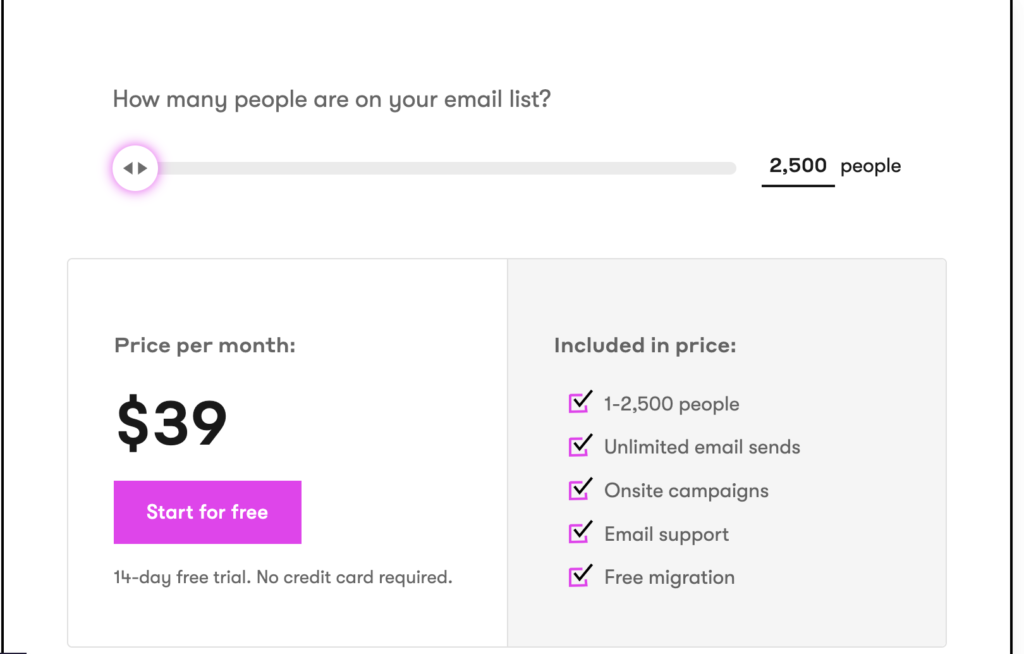
TinyEmail
TinyEmail, aligning with its focus on simplicity, presents a more straightforward pricing model. They might offer a flat monthly rate with unlimited emails, or perhaps a tiered system based on usage. It’s essential to note that while their pricing may be more predictable month-to-month, some advanced features available in competitors might be absent.

Comparison
Comparing TinyEmail vs Drip in terms of pricing is not just about numbers. It’s also about understanding the value proposition of each. Drip, with its scalable pricing, might be more suitable for businesses with growing email lists, while TinyEmail’s transparent pricing could appeal to those who prefer a predictable monthly expenditure.
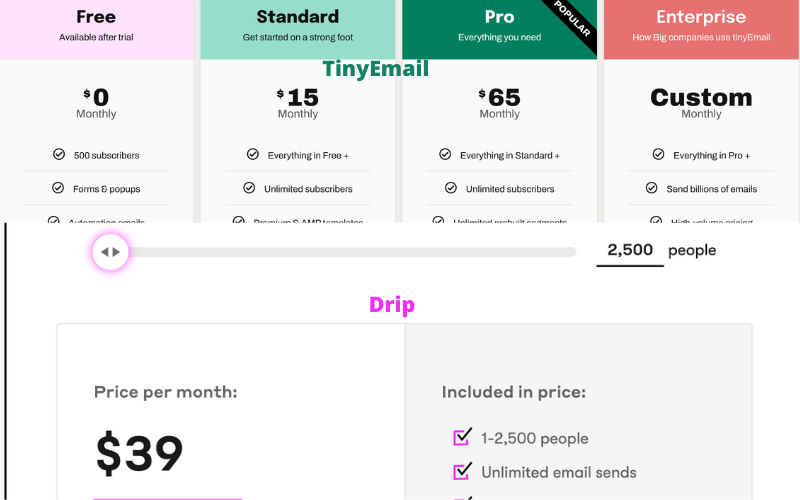
In conclusion, when weighing the pricing and plans in the Drip vs TinyEmail debate, it boils down to your business’s specific needs and growth trajectory. While Drip offers scalability, TinyEmail might win points for predictability and simplicity.
Email Automation Features
Email automation remains a game-changer in the world of digital marketing, allowing businesses to engage audiences efficiently and personally. In the Drip vs TinyEmail comparison, understanding each platform’s automation capabilities is key to selecting the right tool for your needs.
Drip
Drip prides itself on its advanced email automation features. With Drip, users can set up intricate trigger-based campaigns, ensuring that subscribers receive personalized content based on their behaviors and preferences. Features like cart abandonment reminders, post-purchase follow-ups, and tailored welcome sequences make it a favorite among e-commerce businesses. Additionally, its visual workflow builder aids in the seamless creation and visualization of automation sequences.
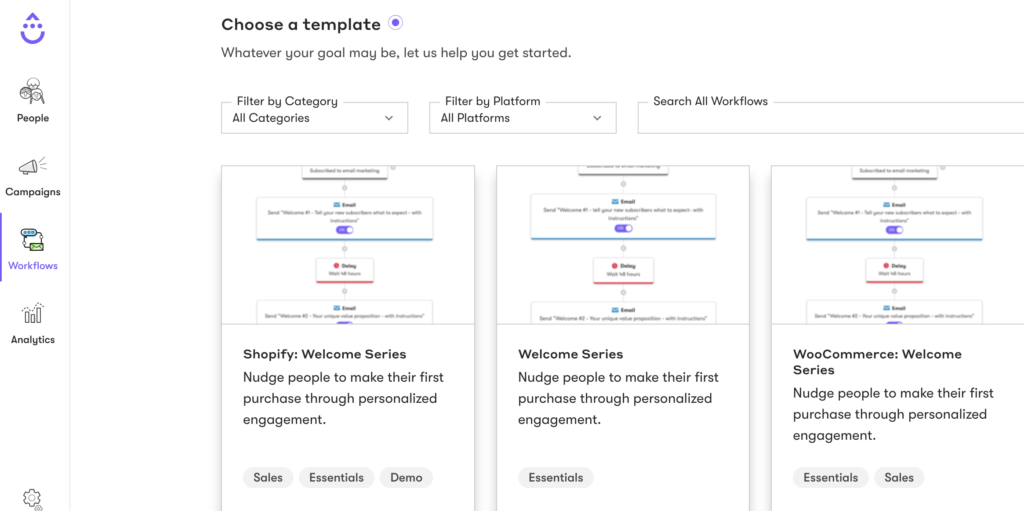
TinyEmail
TinyEmail, staying true to its ethos of simplicity, provides a more streamlined approach to email automation. While it might lack the in-depth customization options seen in platforms like Drip, it covers the basics exceptionally well. Users can set up automated welcome emails, timed promotional campaigns, and regular newsletters with ease. The platform focuses on ensuring that even beginners can set up basic automation without feeling overwhelmed.

Comparison
The Drip vs TinyEmail showdown in terms of email automation features presents a clear distinction between complexity and user-friendliness. Drip is designed for those who seek in-depth personalization and segmentation, while TinyEmail caters to those who want the basics done right without the bells and whistles.
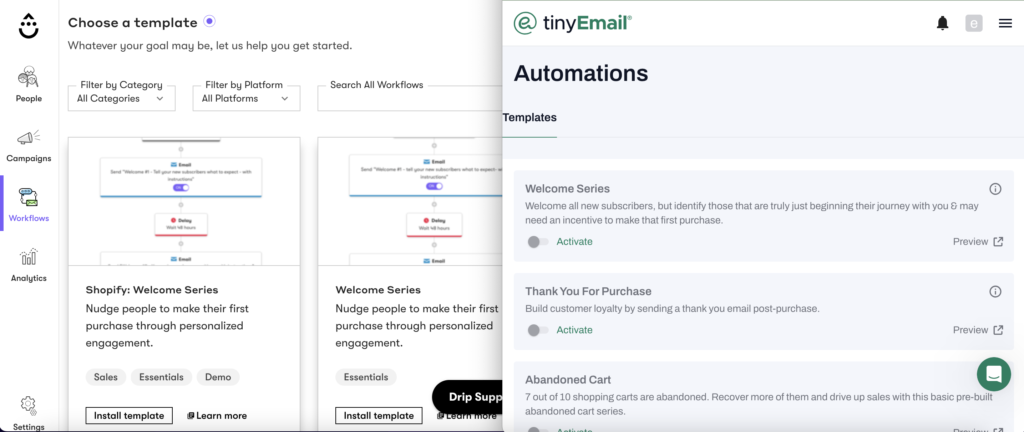
To summarize, the choice between Drip and TinyEmail for email automation largely hinges on your business’s specific needs. If intricate customization and detailed automation sequences are priorities, Drip might have the edge. However, for those seeking a straightforward solution with essential features, TinyEmail stands as a worthy contender in the Drip vs TinyEmail debate.
Segmentation and Personalization
Segmentation and personalization are critical tools in the modern email marketer’s arsenal, allowing for more tailored and relevant messaging. When examining Drip vs TinyEmail, it’s crucial to determine which platform offers the tools and flexibility to match your audience engagement needs.
Drip
Drip shines in its ability to deeply segment and personalize email campaigns. Users can easily categorize subscribers based on behavior, purchase history, interaction with past emails, and more. This granular approach ensures that your messages reach the right audience at the right time. Moreover, Drip’s dynamic content allows marketers to alter parts of their emails based on individual subscriber data, making each email feel like it was crafted for the recipient.

TinyEmail
In the Drip vs TinyEmail analysis, TinyEmail offers a more simplified take on segmentation and personalization. While it might not have the depth that Drip provides, it handles the basics effectively. Users can segment subscribers based on general criteria like sign-up date, location, or engagement level. Personalization options, though fewer, ensure that marketers can still add touches like first-name customization and tailored product recommendations.
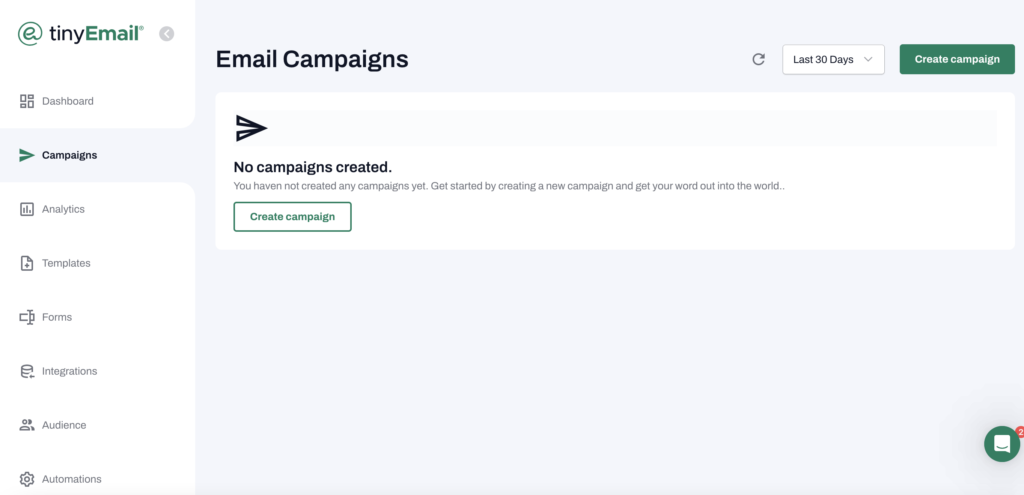
Comparison
Drip offers a more comprehensive toolkit for those who seek detailed segmentation and hyper-personalized messaging. Its capabilities cater to businesses that need to address a diverse and segmented audience. On the contrary, TinyEmail is the go-to for marketers who prefer a no-frills approach, ensuring basic segmentation with straightforward personalization.

In wrapping up, the Drip vs TinyEmail debate in the realm of segmentation and personalization boils down to detail versus simplicity. For in-depth, tailored audience engagement, Drip takes the lead. However, if the goal is to effectively address your audience with simpler tools and a shorter learning curve, TinyEmail could be your pick.
Integration Capabilities
In today’s interconnected digital landscape, integration capabilities can significantly influence an email marketing platform’s success. The ability to seamlessly connect with other tools and services amplifies a platform’s utility. In the Drip vs TinyEmail conversation, understanding their respective integration landscapes becomes vital.
Drip
Drip boasts a robust ecosystem of integrations. Whether you’re looking to connect your e-commerce platform, CRM, or even a third-party analytics tool, Drip likely has an integration to streamline the process. Their API is also known for its flexibility, enabling businesses to create custom connections where needed. This vast array of integrations ensures that Drip can comfortably fit into most marketing tech stacks.
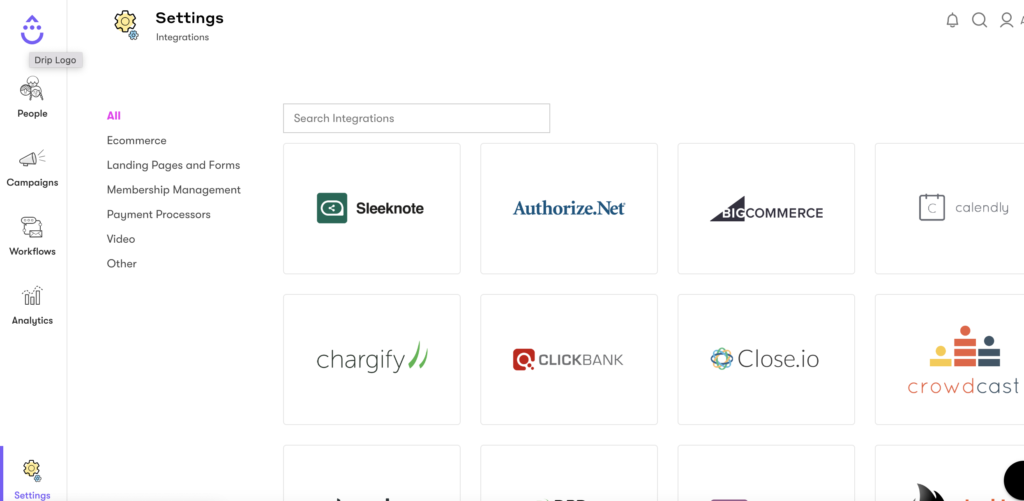
TinyEmail
Navigating the Drip vs TinyEmail terrain, TinyEmail offers a more curated list of integration options. While it might not provide the extensive array seen with Drip, it covers essential bases, ensuring that users can connect their primary tools and services. TinyEmail’s focus remains on simplicity, so their integrations are often straightforward and easy to set up, making it a great option for those who aren’t looking for an exhaustive list of connectors.

Comparison
When comparing TinyEmail vs Drip based on integration capabilities, it’s a balance between depth and simplicity. Drip caters to those with a diverse toolset and a need for intricate integrations. In contrast, TinyEmail is geared towards businesses that require key integrations without the complexity of an extensive ecosystem.

Concluding, your choice in the Drip vs TinyEmail debate, concerning integration capabilities, hinges on your business’s specific needs. Drip emerges as the choice for integration-heavy marketers, while TinyEmail appeals to those looking for essential connections without the potential overwhelm.
Reporting and Analytics
For email marketing campaigns, the ability to measure performance and gain insights is invaluable. Efficient reporting and analytics tools empower users to refine their strategies and enhance engagement. When weighing Drip vs TinyEmail, considering their analytical capabilities is of paramount importance.
Drip
Drip offers a comprehensive analytics dashboard, providing deep insights into subscriber behavior, campaign performance, and conversion rates. Users can track everything from open rates and click-through rates to revenue generated from specific campaigns. Their visualization tools, such as graphs and charts, make it easy to understand data at a glance. Moreover, with Drip, you can segment analytics based on various criteria, offering a more granular view of your audience’s behavior.
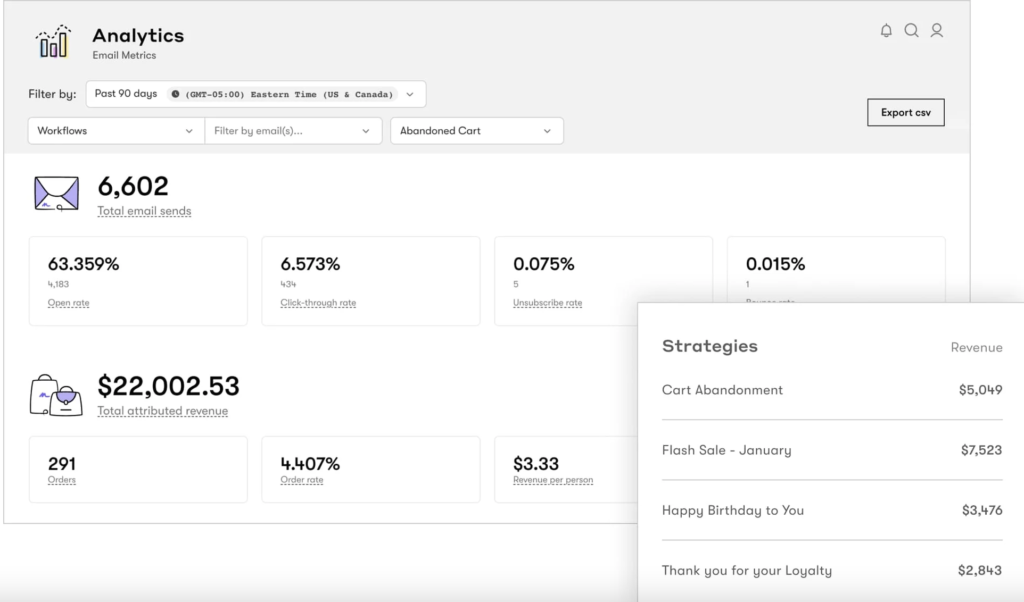
TinyEmail
In the Drip vs TinyEmail analysis, TinyEmail provides a more condensed yet effective analytics suite. It focuses on delivering key metrics that most marketers rely on—open rates, bounce rates, and subscriber growth. While it may not delve into the advanced analytics realm as Drip does, TinyEmail ensures that users get a clear picture of their campaign’s performance without the complexity of data overload.

Comparison
When comparing Drip vs TinyEmail based on their analytical tools, the distinction becomes one of depth versus clarity. Drip serves those who desire intricate data insights and the ability to dive deep into performance metrics. On the other hand, TinyEmail is a fit for marketers who want straightforward, easy-to-digest analytics.

In conclusion, your decision in the Drip vs TinyEmail debate, with respect to reporting and analytics, will align with your appetite for data. If you’re looking for advanced, in-depth insights, Drip is the way to go. However, if simplicity and clarity in analytics are your priorities, TinyEmail holds its ground effectively.
Templates and Design Capabilities
An email’s design can be as critical as its content. Visually appealing templates that resonate with the brand and audience can significantly impact engagement rates. In the TinyEmail vs Drip match-up, the quality, variety, and flexibility of design capabilities play a pivotal role.
Drip
Drip comes equipped with a broad array of responsive email templates, suitable for a diverse range of campaigns—from newsletters to product launches. Their drag-and-drop editor is both intuitive and flexible, enabling users, regardless of their design proficiency, to craft beautiful emails. One of Drip’s standout features is its customization capabilities; users can tweak every aspect of the template, aligning perfectly with brand aesthetics.

TinyEmail
Positioning TinyEmail in the Drip vs TinyEmail design discussion, TinyEmail takes a minimalist approach. They offer a selection of clean, straightforward templates that are designed for quick customization and deployment. While they may not have the vast variety seen with Drip, what they provide is optimized for clarity and readability. TinyEmail’s design tools focus on ensuring that creating visually appealing emails remains accessible to all, even those without a design background.
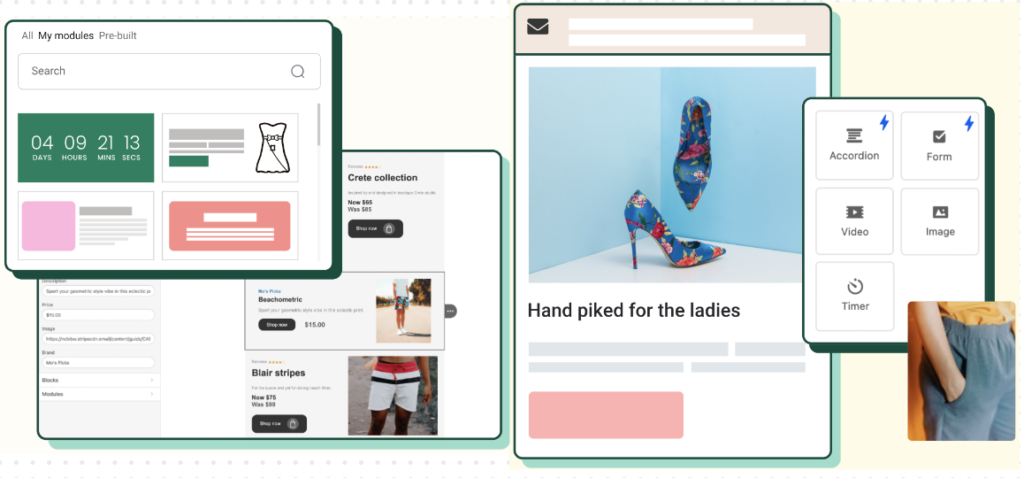
Comparison
In the arena of design, the Drip vs TinyEmail battle is one of extensive customization versus streamlined simplicity. Drip is tailored for those who desire detailed design control and variety, while TinyEmail caters to users looking for quick, efficient, and clean email designs.
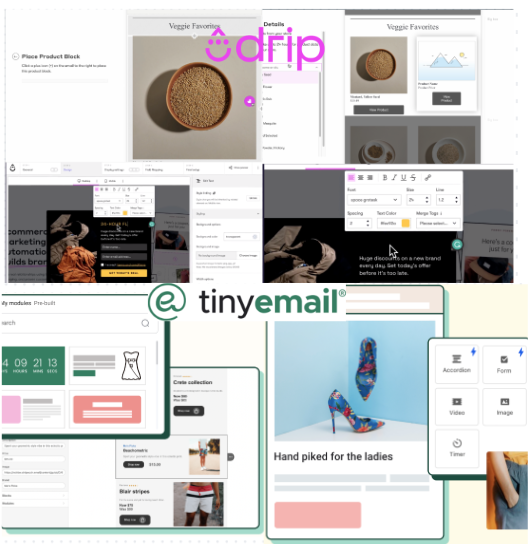
Summing up, if your aspirations lean towards intricate design customization and an expansive template library, Drip stands out in the Drip vs TinyEmail comparison. However, for those who prioritize fast, clean designs without a steep learning curve, TinyEmail delivers commendably.
Deliverability Rates
One of the primary concerns for email marketers is ensuring that their messages land in the recipient’s inbox and not the spam folder. In the Drip vs TinyEmail debate, understanding the deliverability rates of each platform can provide a clearer perspective on their effectiveness.
Drip
Drip’s reputation for high deliverability rates is well-founded. With its advanced email infrastructure and ongoing efforts to adhere to best practices, Drip ensures that emails have the best chance of reaching their intended audience. Regular updates, domain authentication tools, and thorough testing methodologies contribute to maintaining its strong deliverability stats.

TinyEmail
When discussing Drip vs TinyEmail in terms of deliverability, TinyEmail too makes a solid case. While it may not have the extensive infrastructure of larger platforms, its streamlined approach focuses on quality over quantity. By emphasizing sender reputation, adhering to email sending guidelines, and providing tools to optimize campaigns, TinyEmail manages to uphold commendable deliverability standards.

Comparison
Comparing Drip vs TinyEmail based on deliverability, both platforms prioritize ensuring emails reach the inbox. However, the differences lie in their methodologies and infrastructure. Drip leverages its expansive resources to offer consistently high deliverability, while TinyEmail’s leaner approach is about optimizing each campaign for best results.

In conclusion, whether you lean towards Drip or TinyEmail in the deliverability rates discussion depends on your preference—robust infrastructure and advanced tools versus a focused, quality-driven approach.
Customer Support and Resources
Email marketing platforms can be complex, and timely support, paired with helpful resources, becomes crucial. When considering Drip vs TinyEmail, it’s essential to gauge the efficiency and effectiveness of their support systems and the richness of their educational resources.
Drip
Drip’s commitment to customer support is evident in their 24/7 availability. Users can reach out via chat, email, or phone, ensuring rapid response times to critical issues. Additionally, Drip boasts an extensive knowledge base complete with tutorials, webinars, and a community forum. These resources cater to both beginners seeking foundational knowledge and advanced users aiming to optimize their campaigns.

TinyEmail
In the Drip vs TinyEmail comparison, TinyEmail offers a more boutique support experience. While their support might not be round-the-clock, the personalized touch and expert insights provided are commendable. Users can typically expect detailed responses that go beyond mere troubleshooting. As for resources, TinyEmail presents a curated selection of guides, FAQs, and video walkthroughs, ensuring users can navigate their platform with confidence.
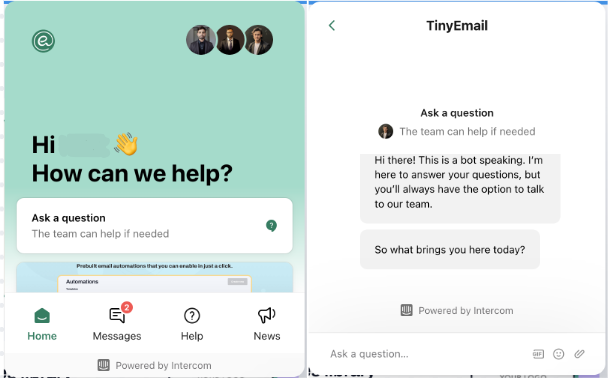
Comparison
When stacking Drip vs TinyEmail based on customer support and resources, the distinction is clear. Drip offers a comprehensive, always-available support mechanism bolstered by an expansive resource library. In contrast, TinyEmail provides a more tailored support experience, complemented by a focused set of educational tools.
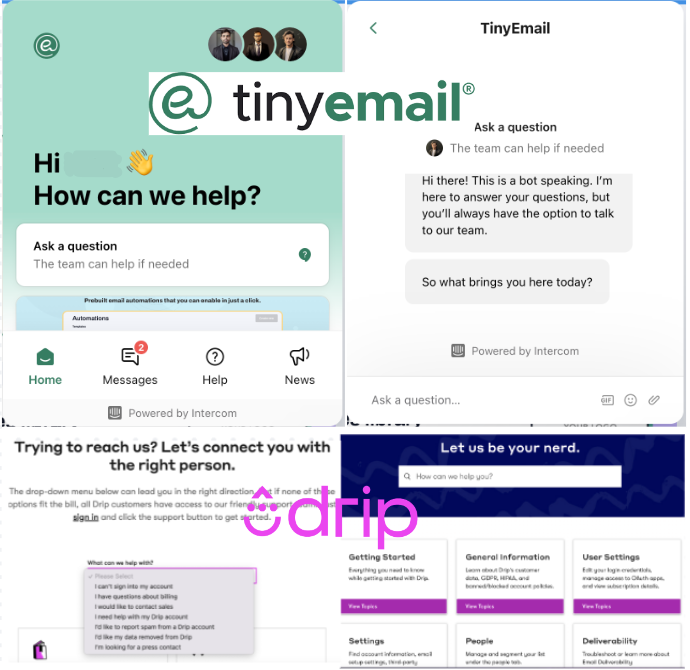
In conclusion, the choice between Drip and TinyEmail in the realm of support and resources depends on preference. If 24/7 availability and extensive resources appeal to you, Drip is a strong contender. However, if you value personalized support and streamlined educational content, TinyEmail might be the right fit.
Scalability
For growing businesses, the ability of an email marketing platform to scale alongside them is pivotal. It’s not just about handling an expanding subscriber list but also meeting the evolving complexities of campaigns. Let’s explore the scalability factor in the Drip vs TinyEmail context.
Drip
Drip positions itself as a solution that grows with businesses. Its platform is robust enough to handle vast email lists and the corresponding data influx. Furthermore, Drip’s features, such as advanced segmentation and automation capabilities, can accommodate the sophisticated needs of growing enterprises. The system’s architecture is designed for seamless scaling, ensuring minimal hiccups as businesses expand.
TinyEmail
Turning the spotlight onto TinyEmail in the Drip vs TinyEmail scalability discourse, TinyEmail shines for small to medium-sized businesses. Its intuitive design ensures that new features or expanded capacities can be integrated without overwhelming users. While it may not have the vast infrastructure like some larger platforms, TinyEmail’s focus is on providing quality and smooth performance even as user demands grow.
Comparison
In a direct Drip vs TinyEmail scalability comparison, Drip appears tailored for businesses with ambitious growth trajectories, offering a platform that can match substantial and intricate demands. TinyEmail, on the other hand, emphasizes smooth scalability for smaller enterprises, ensuring they receive the tools they need without unnecessary complexities.
In conclusion, if you foresee rapid, large-scale growth and require a platform that can handle intricate campaign complexities, Drip stands out in the Drip vs TinyEmail debate. For those seeking steady scalability without the bells and whistles, TinyEmail offers a compelling proposition.
Security and Compliance
In an age where data breaches and privacy concerns are paramount, the security and compliance features of email marketing platforms can’t be overlooked. The Drip vs TinyEmail discussion becomes particularly essential when considering the trustworthiness and protection they offer.
Drip
Drip recognizes the gravity of data security. The platform employs advanced encryption methodologies for data at rest and during transmission. Regular security audits and vulnerability assessments ensure that the system is always fortified against potential threats. Moreover, Drip is compliant with GDPR, showcasing its commitment to global data protection standards.
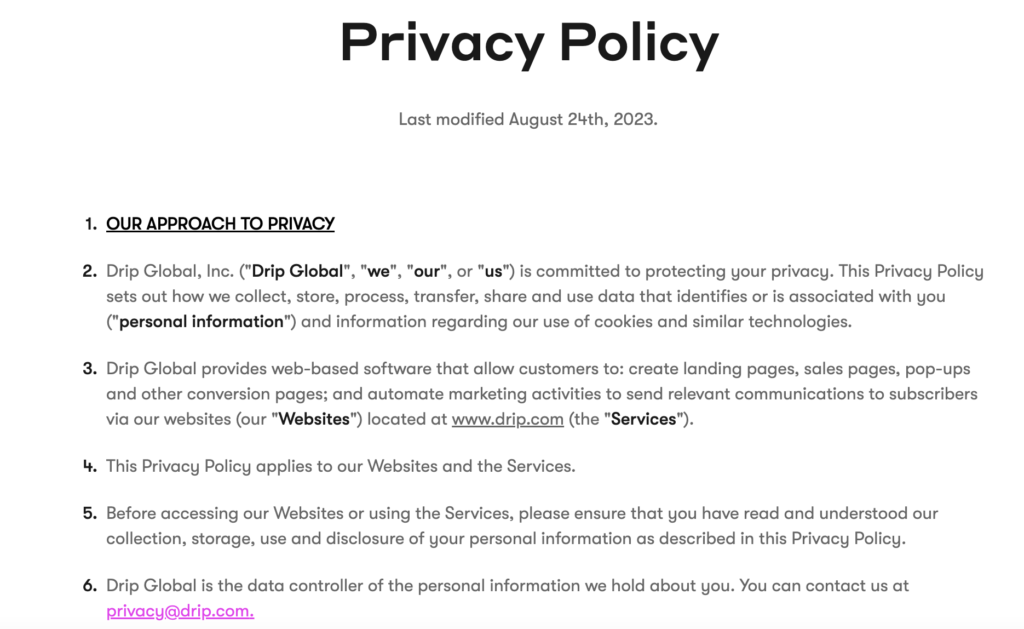
TinyEmail
When diving into the security aspects of TinyEmail in the Drip vs TinyEmail dialogue, one notes its emphasis on transparency and user trust. While perhaps not as extensive in its security protocols as some larger players, TinyEmail offers solid encryption, regular security patches, and transparent data policies. Its focus is on providing a secure environment that is both user-friendly and compliant with prevailing regulations.

Comparison
Drawing a parallel between Drip and TinyEmail concerning security and compliance, both platforms prioritize user data’s safety. Drip’s vast infrastructure allows for rigorous security checks and global compliance. At the same time, TinyEmail ensures a secure experience with clear data policies and up-to-date security measures.
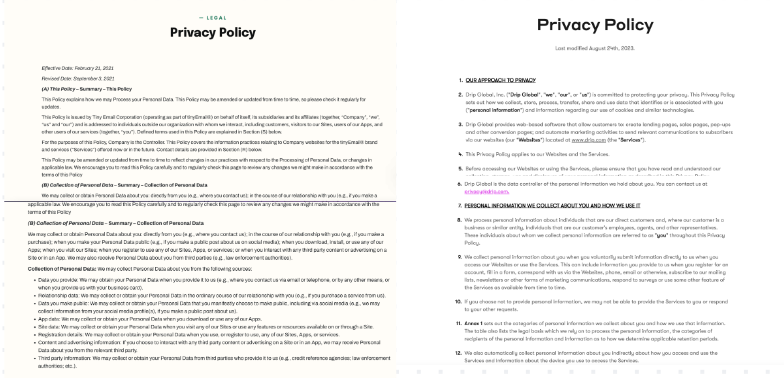
In conclusion, in the Drip vs TinyEmail comparison for security and compliance, both platforms are dedicated to safeguarding user data. Your choice will hinge on whether you seek a platform with extensive security protocols or one that combines security with transparent and user-centric policies.
Feedback and Reviews
User feedback and reviews offer an invaluable perspective when assessing the true value of a product. By delving into these, we gain insights into real-world experiences and can better gauge the strengths and weaknesses of email marketing platforms. Here’s a look at how the Drip vs TinyEmail debate fares when based on user testimonials.
Drip
Drip generally garners positive reviews for its comprehensive automation tools and robust features. Users appreciate the visual workflow builder and the ease of segmenting their audience. However, some feedback highlights concerns over the learning curve for beginners and occasional technical glitches.
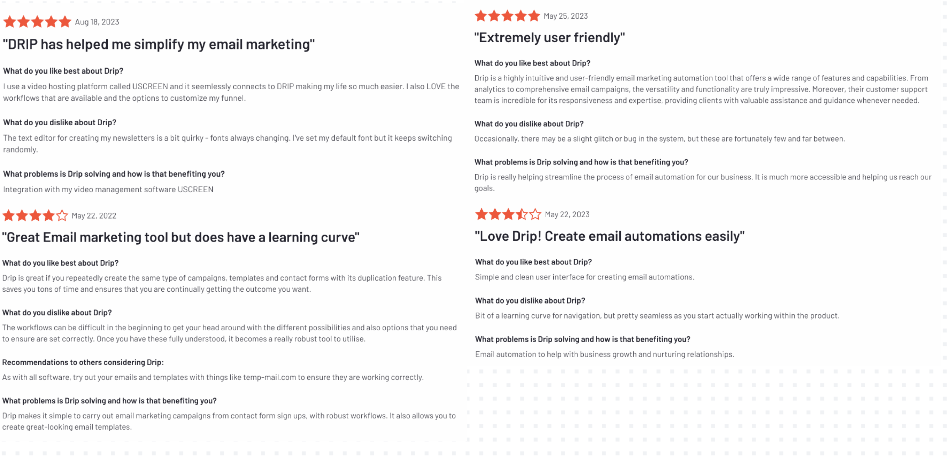
TinyEmail
Within the Drip vs TinyEmail feedback spectrum, TinyEmail is often lauded for its straightforward interface and hassle-free setup. Users particularly value the platform’s simplicity and effectiveness for small to medium-sized campaigns. On the flip side, some reviewers wish for more advanced features or integrations.
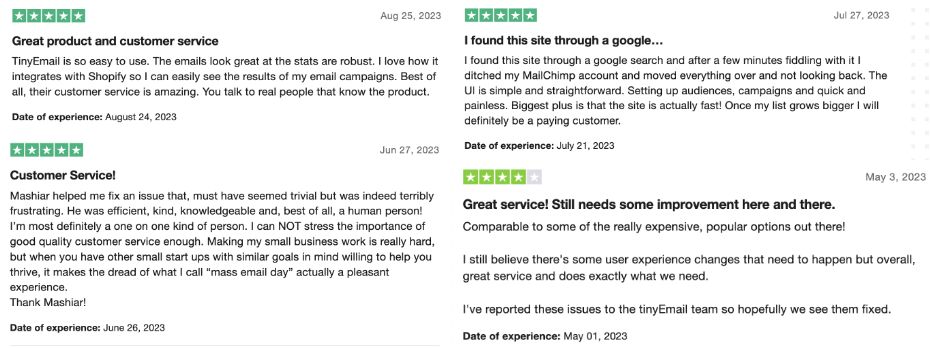
Comparison
Comparing the feedback for Drip and TinyEmail reveals distinct user preferences. While Drip attracts those who prioritize advanced features and detailed analytics, TinyEmail resonates with businesses seeking an uncomplicated, efficient email marketing solution.
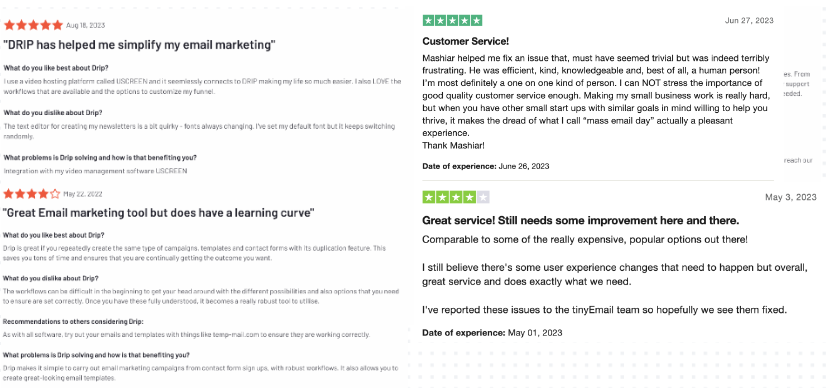
In conclusion, when navigating the Drip vs TinyEmail debate based on feedback and reviews, it’s clear that the best platform for you will align with your business needs and personal preferences. Always consider real user experiences and reviews alongside feature lists to make an informed decision.
Key Differentiators
When considering email marketing platforms, it’s the unique features and standout qualities that often sway a decision. Delving into the Drip vs TinyEmail showdown, let’s uncover the defining attributes that set each platform apart.
Drip
Drip differentiates itself by focusing on e-commerce CRM solutions. This means beyond just email marketing, Drip provides tools tailored for e-commerce businesses, such as integration with shopping carts and product recommendation engines. Another defining trait is its advanced automation capabilities, which are complemented by a visually intuitive workflow builder, making it both powerful and user-friendly.
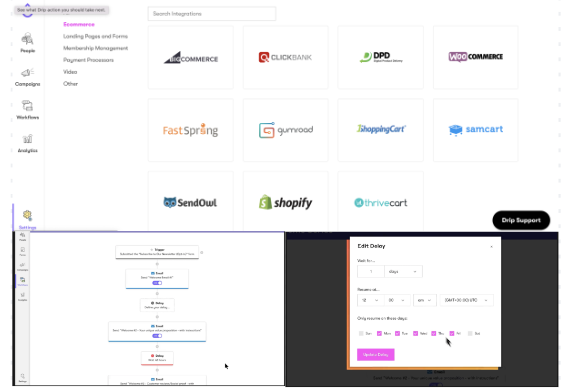
TinyEmail
Diving into the distinct facets of TinyEmail in the Drip vs TinyEmail narrative, TinyEmail prides itself on sheer simplicity. Stripping away the often-overwhelming layers found in extensive platforms, TinyEmail offers a streamlined, efficient, and direct approach to email marketing. Its unique selling proposition lies in delivering core functionalities without bogging users down with complexities.

Comparison
In a direct Drip vs TinyEmail differentiation, Drip appears as the go-to for businesses entrenched in e-commerce, seeking sophisticated automation tools. TinyEmail, conversely, is the ideal pick for those who yearn for a no-frills, straightforward email marketing experience.

To sum it up, the choice between Drip and TinyEmail hinges on individual needs. If e-commerce integrations and advanced automations align with your requirements, Drip holds the edge. However, for those seeking simplicity and ease, TinyEmail stands tall in the Drip vs TinyEmail landscape.
Conclusion: Drip vs TinyEmail
Navigating the landscape of email marketing platforms can be a daunting endeavor. The Drip vs TinyEmail debate underscores the varied options available to businesses and marketers today. Both platforms, with their respective strengths and focus areas, cater to different needs and preferences.
Drip emerges as a powerful contender for those seeking extensive automation, e-commerce integrations, and a feature-rich environment. Its capabilities are tailor-made for businesses keen on a robust and comprehensive solution that evolves with their growth.
TinyEmail, on the other hand, resonates with those prioritizing simplicity, efficiency, and a hassle-free email marketing experience. It embodies the essence of getting the basics right and streamlining the email marketing process without unnecessary complications.
Your final choice should reflect your business goals, technical comfort level, and desired features. Whether you gravitate towards the detailed intricacies of Drip or the straightforward approach of TinyEmail, ensure that your selected platform aligns with your objectives and audience engagement strategy.
In the Drip vs TinyEmail comparison, there isn’t a one-size-fits-all winner. It’s about finding the right fit for your unique journey. Happy emailing!
For readers keen on diving deeper into the capabilities and nuances of TinyEmail, our comprehensive comparison of Constant Contact vs TinyEmail offers a detailed exploration. Discover how TinyEmail fares against another major player in the email marketing realm and equip yourself with more insights for making an informed decision.





